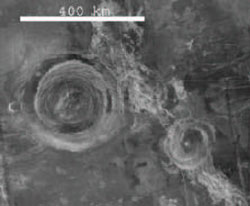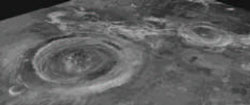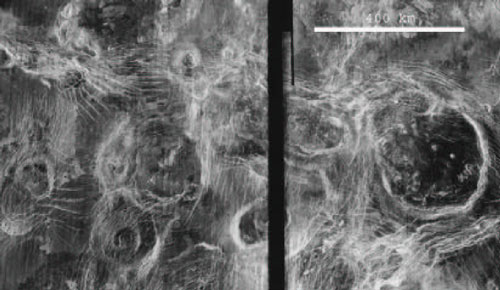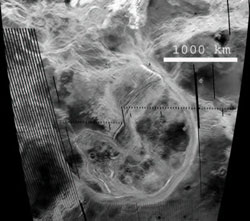 |
 |
Cold,
plumeless Venus has an ancient accretionary surface |
|
|
The Venus of conventional
interpretation is currently inactive but was wholly
resurfaced, mostly by plume-driven processes, no earlier
than 1 Ga. This speculation is extrapolated from terrestrial
plume conjectures, and ignores voluminous contrary evidence
from Venus itself. Venus displays thousands of old circular
structures, with topographic rims 5-2000 km in diameter,
that have the morphology, cookie-cutter superposition,
and frequency/size distribution required of, and unique
to, impact craters and basins. Many structures have
interior central- or ring uplifts or broad, low volcanic
constructs. Many are multi-ring. At least 700 of these
exposed circular structures have topographic-rim diameters
> 100 km. Old uplands are saturated with these structures,
which are variably eroded, whereas lowland structures
are partly to entirely buried. The youngest include
three of the largest (inside rim diameters 2000, 900,
and 800 km). Analogy with the dated, large, and similarly
young, Imbrium impact basin on the Moon requires ages
of 3.85 or 3.90 Ga for these youngest megabasins. Venus
preserves much of its surface of late-stage main planetary
accretion and is, by comparison to Earth, cold and dead. |

Figure 1a

Figure 1b
|
Figure1: Ancient circular
structures with impact-crater morphology.
(a) Magellan radar mosaic
of multiring Aramaiti “corona” (left,
location 26°S, 82°E) has a rim steeper
on the inside than the outside; basin floor
lower than the surrounding plains; a central
uplift; an erosion-smoothed conical ejecta apron
sloping gently from rim into the outer syncline;
and, almost imperceptible here, a broad outer
rise with an outside diameter of 400 km. Multiring
Ohogetsu “corona” (right) also has
a rim, central uplift, and ejecta apron. These
coronae are in the plains, where most structures
are buried by sediments.
(b) pseudoperspective view
northeastward, vertical exaggeration 3:1, made
by Trent Hare by draping a radar-brightness
image on a digital topographic model.
|
|
Conventional analysis
assumes these thousands of circular structures to be
entirely young and endogenic. Interpreters of early
Venusian radar imagery accepted their possible impact
origin and great age, but in the late 1980s impact explanations
were replaced, almost without analysis, by plume conjectures.
Nearly all specialists now assume that Venus has a thermal
structure and heat loss comparable to that of Earth,
and that its only impact structures are 1000 “pristine”
small to midsize craters (maximum rim diameter, 270
km) with a presumed age of < 1.0 Ga. (Ages as old
as 3.9 Ga are advocated here for them.) The conventional
logic is false: all true impact structures are “pristine”,
so therefore all modified structures are endogenic.
The older circular structures are rationalized, in these
terms, as produced by mantle plumes and upwellings that
deform crust and upper mantle from beneath, with or
without extrusion of subordinate lava, and that magmatically
and tectonically resurfaced Venus in a brief period
before the late impacts. |
|
Figure 2:
Cookie-cutter superposition of ancient circular
impact structures. The rim of Ved-Aua “corona”
(impact basin, upper right; topographic rim is
approximately the outer ring of continuous concentric
fractures) is 200 km in diameter and stands 1-2
km above the irregular floor of the enclosed basin.
It is superimposed across a subdued and partly
buried impact-crater rim 250 km in diameter. The
common assumption that both are products of plumes
is disproved by this geometry. The area is centered
on -32.5°N, 141.5°E. East-looking radar
mosaic by U.S. Geological Survey. |
|

Figure 3: Terrain saturated with
ancient impact structures. All circular structures
in this view are here regarded as of impact origin.
Impact-basin Ki “corona” (E-center) has
300-km-diameter rim, steeper on the inside than the
outside and 1 km high, that retains an ejecta blanket
to E and S and is cut by 65-km crater in the N. The
many other old impact structures, with rims from 15
to 200 km in diameter, show varying superpositions
and degrees of preservation. The only structure conventionally
attributed to impact in this view, tiny Yerguk Crater,
shows as a 2-mm light spot just inside the WSW rim
of Ki; many more small, subdued ancient craters are
present. Area extends from 40° to 47°N and
is centered on 222°E. Radar mosaic by the Jet
Propulsion Laboratory.
|
Transfer of plume conjecture to Venus
from Earth has little merit. Terrestrial plume speculation
is based on assumptions whose predictions have been
consistently falsified. Not only do plumes probably
not exist on Earth, but even the most fanciful attributions
of geologic and tectonic features to them do not include
circular structures that in any way resemble those
of Venus. Venusian speculations are unconstrained
and yet neither address nor account for circularity
and superpositions. The hot-Venus assumption behind
young-surface conjectures also is dubious. Venus’
lack of a magnetic field (her core is likely solid),
positive correlation of topography and geoid (outer
Venus is much stiffer than Earth), origin close to
the Sun (less potassium, so much less early radiogenic
heat), and other factors indicate Venus to be much
colder internally than Earth below the depth of influence
of its greenhouse atmosphere.
The quasi-pristine craters can be discriminated
only arbitrarily from the best-preserved of the ancient
circular structures. From those in turn, there are
all gradations back to the deepest-eroded, or the
most-buried, structures of the old family. Broad,
low volcanic constructs (unlike any terrestrial volcanoes)
inside impact basins likely are products of impact
melts. Other broad, low volcanoes also are circular,
isolated, and may be of impact melts that buried their
basins. Broad tessera-surfaced plateaus are of layered
rocks, display deformation and topography indicative
of outward gravitational spreading, and may have formed
from ancient impact-melt lakes.
Venusian lowlands are floored not by
young lava plains but by ancient sediments, possibly
including deposits in a transient ocean, derived from
uplands by processes still poorly defined. The plains
are speckled with mud volcanoes (not lava cones) that,
like minor deformation of the sediments, are due to
top-down heating by the evolving atmosphere.
|

Figure 4a

Figure 4b
|
Figure 4: Radar mosaic and
pseudoperspective view of the huge Artemis impact
basin.
(a) inward-facing rim, 2000
km in diameter, is approximately at the inner
edge of a radar-bright concentrically fractured
zone. NW part of the structure is obscured by
erosion and younger constructs. Mosaic, by the
USGS, extends from 15° to 45°S and from
115° to 150°E.
(b) pseudo-perspective view
NE over eastern Artemis. Inner rim (passes through
lower-left corner, and bright spot right of
center) stands 1 km above the interior. Ring
syncline (most of radar-bright grooved terrain,
plus half that width more into encircling radar-dull
terrain, to inconspicuous crest of outer rise)
is typically 200 km wide and 2 km deep. Outer
slope of outer rise (mostly out of view) is
a very gentle cone (an erosion-modified ejecta
blanket?) that merges, in huge lobes and with
an outer diameter of 4000 km, with the plain
to the south. Vertical exaggeration 3:1; prepared
by Trent Hare, USGS.
|
|
For more on this, see:
Hamilton,
W. B., Plumeless Venus preserves an ancient impact-accretionary
surface, in Plates, Plumes, and Paradigms,
edited by G. R. Foulger, J.H. Natland, D.C. Presnall
and D.L. Anderson, pp. 781-814, Geological Society
of America, 2005.
|
last updated June
15th, 2006 |
|
|
